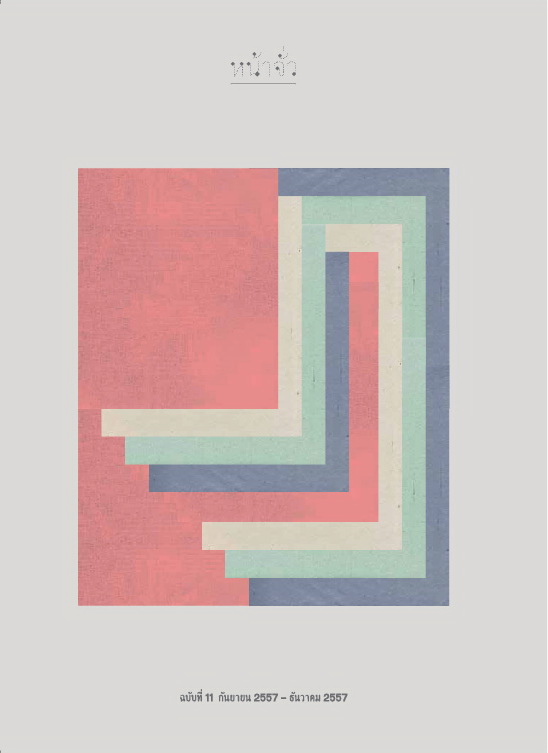มองสถาปัตยกรรมผ่าน “ความสะดวกสบาย” ในโลกไร้เทคโนโลยี Shaking ‘The Modern Constancy’ The study of ‘conveniences’ in architecture in the age of non-technology
Main Article Content
Abstract
บทคัดย่อ
“ความสะดวกสบาย” คือหนึ่งคุณสมบัติสำคัญในสถาปัตยกรรมแทบทุกยุคทุกสมัย ปัจจุบันความหมายและความเข้าใจของคำว่าความสะดวกสบายถูกตีความเป็นเพียงสิ่งที่ตอบสนองความต้องการของผู้อยู่อาศัยเชิงกายภาพเท่านั้น ความสะดวกสบายจึงกลายเป็นสิ่งแน่นิ่งตายตัว ถึงอย่างไรคำว่า “convenience” หรือความสะดวกสบายนั้นถูกใช้กันมาตั้งแต่อดีตในบริบทที่แตกต่างกันออกไป บทความนี้จึงพยายามค้นหามิติที่ลึกกว่าของความหมาย โดยใช้บ้านหรืออาคารที่อยู่อาศัยเป็นจุดเริ่มต้น ไม่ว่าจะเป็นห้องหลายประตูในอิตาลี ศตวรรษที่ 16 ห้อง 1 ประตูกับทางเดินลับของบ้านอังกฤษในศตวรรษที่ 19 ห้องไม่มีชื่อของสถาปัตยกรรมญี่ปุ่นในศตวรรษที่ 17 และบ้านจักรกลของเยอรมันในต้นศตวรรษที่ 20 โดยความลับที่ได้จากการค้นหาแสดงให้เห็นถึงความหมายที่หลากหลายและต่างกันออกไปอย่างสิ้นเชิง เช่น ความสะดวก สบายในโลกตะวันตกเคยหมายถึงทั้งโอกาสของการพบปะและปลีกตัวระหว่างคนในครอบครัว ต่อมากลับกลายเป็นความสะดวกสบายทางร่างกายที่ต้องอาศัยเทคโนโลยี ในขณะที่ความสะดวกสบายในโลกตะวันออกกลับสื่อถึงความสามารถในการปรับตัวในการอยู่อาศัย ทั้งในความหมายเชิงกายภาพ สังคมและจิตวิญญาณ ฉะนั้นบทความจึงตีแผ่คุณสมบัติของคำที่ไม่หยุดนิ่ง หากเคลื่อนไหวผ่านสถานที่และกาลเวลา ท้ายที่สุดทำให้เราได้หยุดคิดถึงความเหมาะสมของสถาปัตยกรรมในปัจจุบันที่มีบางสิ่งขาดหายและเสนอทิศทางที่มันควรมุ่งไป
Abstract
‘Convenience’ has been one of the most important properties that architects in every era concern in the sake of constructing dwelling. Recent days, the notion of convenience has been, in general, considered practically as a basic human need in an act of inhabiting. Ultimately, convenience seems to be constant. However, indeed, the word ‘convenience’ has been used, discussed and interpreted in several ways since the past. Thus, this report attempts to examine how various qualities of convenience in architecture have been talked about, especially, focuses in domestic sphere. Then, the report will utilise those information to rethink interior architecture since the past to the present. The study is conducted by analyzing through times and places: Italy in sixteenth century, England in the late nineteenth, Japan in seventeenth century and Germany in 1920s, in order to provide as much as possibility to understand the connotation of convenience in particular circumstances.
By doing so, the study reveals a large amount of differentiation. For instance, on one hand, the western countries considered ‘convenience’ as an essential aid for an achievement of proximity and privacy in family’s members, later ; it was shifted into efficiency of household management so as to save a maximum of time and afford. On the other hand, in eastern world, ‘convenience’ was, surprisingly, conceived as adaptability of inhibiting in all physical, social and spiritual contexts. In conclusion, the report exposes the dynamic quality of convenience, and makes use of those varieties to go beyond the recent restricted notion, and, finally, rethink the idea of today architecture and its aim which should heading to.

